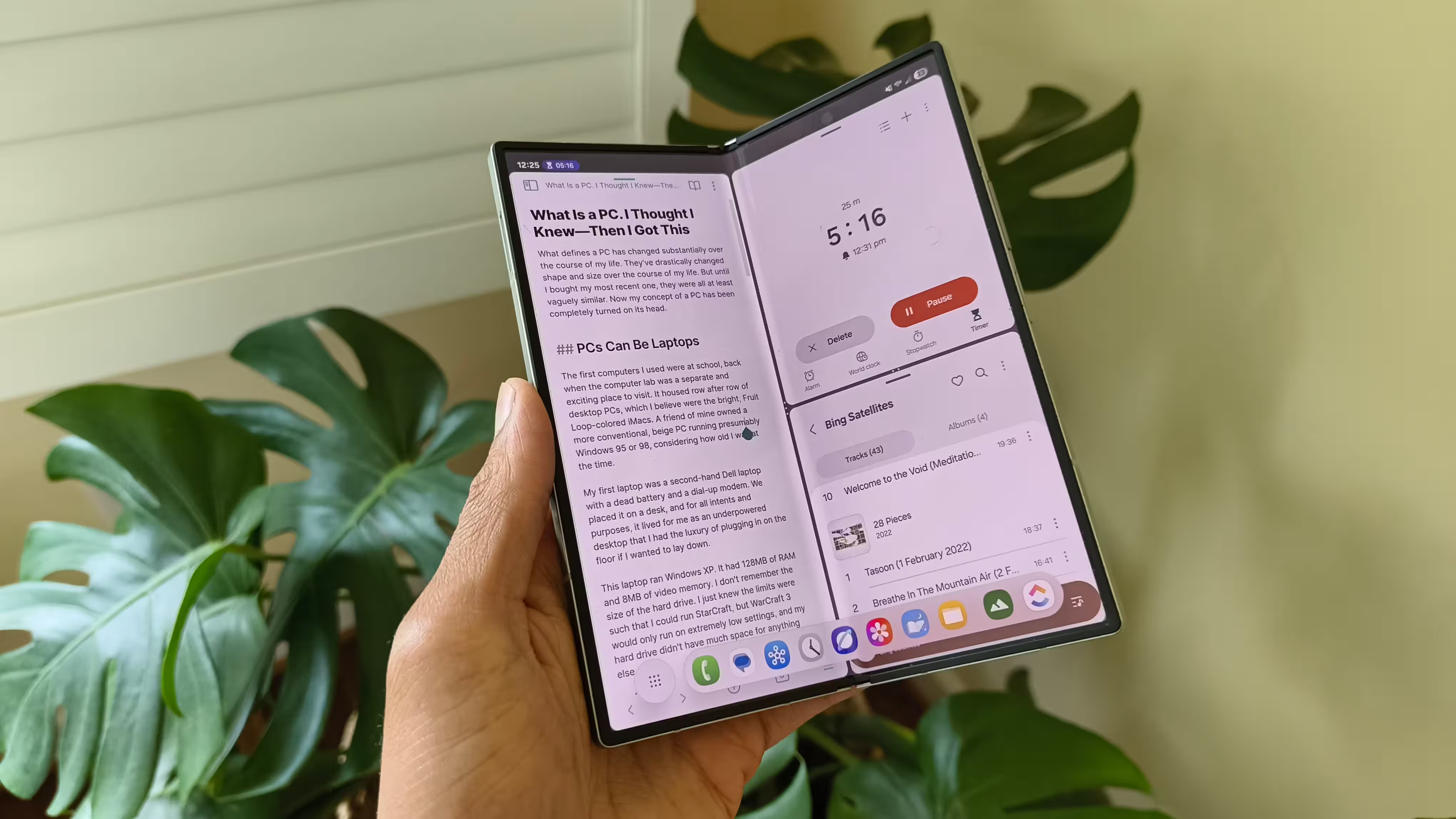6 Minutes
Is the Galaxy Z Fold 7 a Step Back? An In-Depth Comparison with the Z Fold 6
Samsung's highly anticipated Galaxy Z Fold 7 has just landed, bringing with it a sleeker design and a wider cover display. However, after hands-on experience and direct comparison with last year’s Galaxy Z Fold 6, it's clear that not all upgrades are positive. For tech enthusiasts and professionals who use foldable smartphones as portable productivity hubs, a few changes in the Z Fold 7 might actually feel like downgrades. Here’s a detailed look at why the previous generation may still be the better pick for many.
1. Opening the Galaxy Z Fold 7 Feels More Awkward Than Before
Foldable phones are beloved for transforming from pocketable devices to tablet-sized productivity machines. The Z Fold 6 seamlessly delivered this experience, balancing robust construction and a smooth fold action. With the Z Fold 7, Samsung’s pursuit of thinness has taken priority—resulting in a device that sits almost flush like a conventional slab phone but feels noticeably harder to open.

Redesigning the hinge has introduced more resistance, and with less material to grip, it’s harder to unfold the Z Fold 7 compared to its predecessor. Where previous Z Folds made accessing the internal display feel effortless and inviting, the Fold 7’s opening mechanism now demands extra attention—an inconvenience for users who rely on swift, one-handed access to their digital workspace. The famed tablet-in-your-pocket appeal suffers as a result.
2. Larger Internal Display Sacrifices Single-Handed Usability
One of the Z Fold line's most utilitarian features has always been its internal display—large enough for content consumption, yet manageable with one hand. For six generations, Samsung struck a comfortable balance between portability, multitasking, and ergonomics, offering a 7.6-inch inner screen that felt just right.
The Galaxy Z Fold 7 increases this to an 8-inch display, crossing into two-handed device territory. While the bigger screen may appeal to users who prioritize media consumption, ebook reading, digital comics, or productivity tasks like document editing on the go, the device now becomes less practical for one-handed operation. The aspect ratio tweaks haven’t substantially improved the experience for gaming or video, and, in fact, the increased size can hinder fast reading or comfortable browsing—making the Z Fold 7 less versatile for professionals who need flexibility on the move.

3. The End of the Foldable Digital Notebook Era
Many productivity-focused users have embraced foldable phones as more than just communication tools—they're portable digital notebooks, perfect for handwriting, sketching, and real-time note-taking. The Galaxy Z Fold 6 fit this niche beautifully. Smaller than a traditional notebook but, when unfolded, offering a writing canvas wider than a typical Moleskine, its flat design made it ideal for journaling in apps like Samsung Notes or markup in PDFs.
A critical change in the Z Fold 7, however, is the removal of S Pen support entirely. Prior Galaxy Folds allowed for stylus input, whether with the larger, comfy S Pen Fold Edition from the Fold 3 or the slimmer, newer models. The lack of S Pen compatibility in the Fold 7 is a profound shift—one that breaks the dream for writers, artists, and corporate users who depended on this hybrid notebook experience. For those who used their foldable for productive handwriting, brainstorming, or quick note capture, the Z Fold 7 turns its back on a defining use case.
4. Front-Facing Camera Returns to Disruptive Design
A unique selling proposition for earlier Galaxy Z Fold models was the under-display front-facing camera, subtly hidden to provide an uninterrupted viewing experience while browsing, reading, or watching videos. The Z Fold 6’s use of this technology ensured minimal disruption, preserving content immersion.
Samsung has reverted to a traditional hole-punch camera on the Z Fold 7. While this offers a modest step up in selfie quality, it comes at the cost of visual distraction—most noticeably during video playback or when reading comics, where the camera now sits conspicuously in the content area. For those who rarely use the internal selfie camera (given the excellent rear sensors), this design change feels unjustified. Furthermore, the camera bump at the back of the Z Fold 7 has become more pronounced, making the phone less stable and more wobbly when laid on a flat surface—a daily annoyance for many.
5. Speaker Quality Takes a Hit in the Name of Thinness
Audio quality remains a top priority for both casual users and professionals who use their phones for video calls, streaming, or listening to music. Reviews and user feedback have revealed that the Galaxy Z Fold 7’s new super-thin chassis has resulted in smaller, less resonant speakers.
There’s simply less room for powerful audio components and air resonance in this slimmer frame. Unlike with camera bumps, there’s no easy way to compensate for this reduction. The result—audio from the Z Fold 7 sounds noticeably thinner and less dynamic compared to the Fold 6. This is a common drawback with ultra-slim foldables, as echoed in hands-on reports of devices like the Oppo Find N5.

What’s New and Who Is the Galaxy Z Fold 7 For?
Of course, the Galaxy Z Fold 7 brings its own set of advantages. The wider external cover display offers a more familiar phone-like feel for typing, browsing, and quick interactions without unfolding the device. Its slimmer profile slips seamlessly into tighter pockets, aligning closer to standard smartphone ergonomics. For tech enthusiasts obsessed with cutting-edge hardware design and portability, these may be irresistible features.
However, these improvements come at the cost of the Z Fold series' traditional strengths—productivity, versatility, and notebook-like creativity. For power users, professionals, and creative minds drawn to the foldable form factor for its blend of phone and tablet functionality, the Z Fold 6 stands tall as the model that best fulfills this unique promise.
Comparing the Z Fold 6 and Z Fold 7: Which Is Right for You?
The market for foldable smartphones is hotter than ever, driven by innovation from Samsung and competitors like Huawei, Oppo, and Honor. If you value S Pen support, premium audio quality, and a device that truly bridges the gap between phone and tablet, the Galaxy Z Fold 6 remains a top recommendation—especially with Samsung offering seven years of software support, guaranteeing longevity and security updates for years to come.
On the other hand, if you prize ultimate thinness, a wider external display, and are less concerned about stylus input or top-tier speakers, the Galaxy Z Fold 7 still represents a leap in industrial design and pocketability. For early adopters and mobile tech aficionados, weighing these trade-offs will be critical as the foldable market matures.
Final Thoughts
As the foldable phone category evolves, so do user expectations. The Galaxy Z Fold 7 may be a technical marvel, but for many loyal Fold users, it introduces enough compromises to make last year’s model look even more compelling. Whether new software features or future hardware iterations can reconcile these differences remains to be seen. For now, the Galaxy Z Fold 6 continues to set the benchmark for what a productivity-centric foldable phone can be—offering flexibility, creativity, and utility without sacrificing the essentials.



Comments